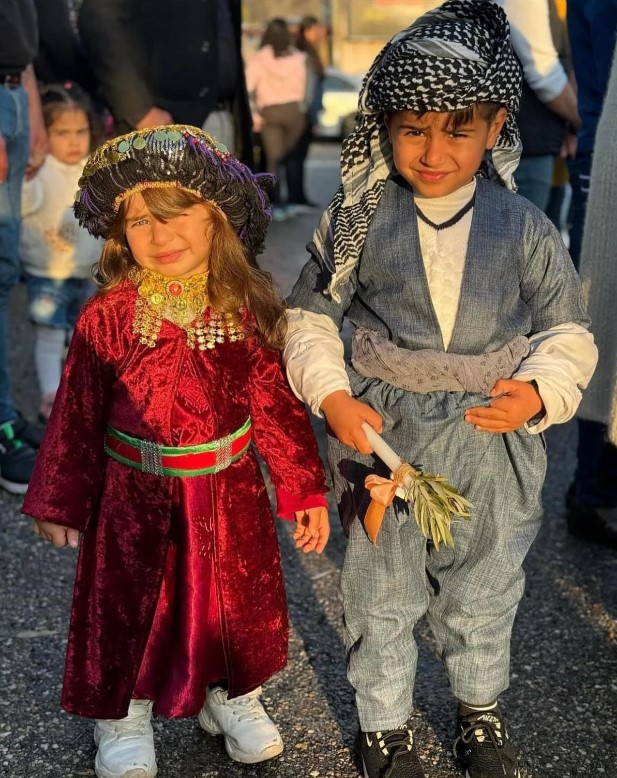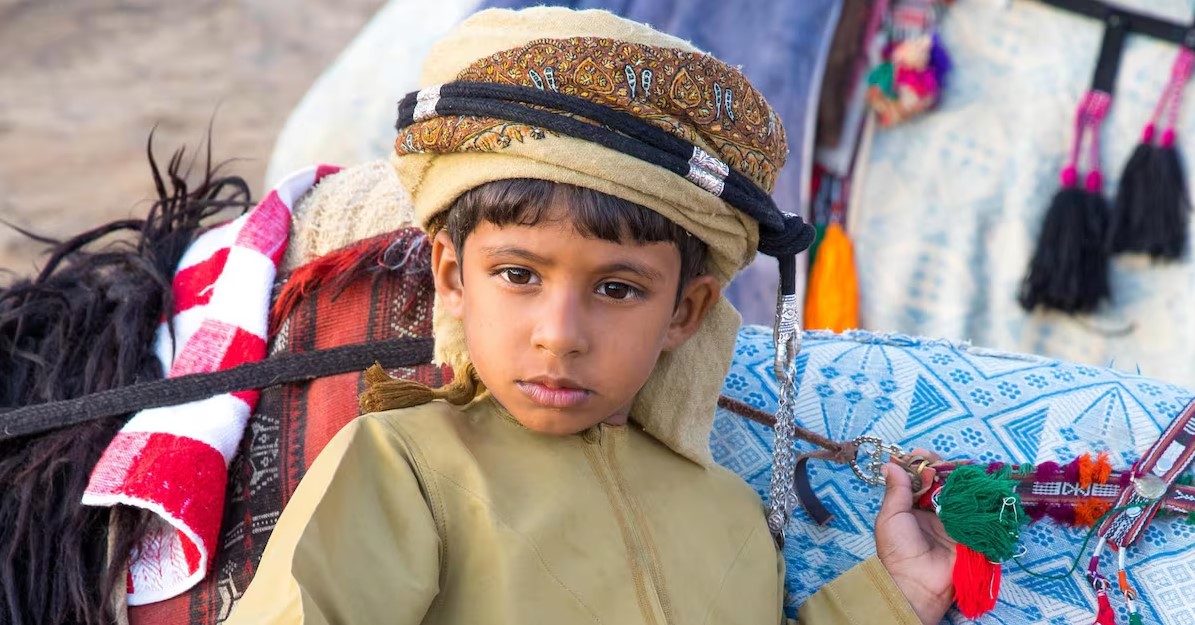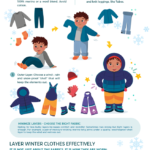Traditional Syrian kids’ clothes reflect a rich cultural heritage. These garments tell stories of history, identity, and community.
In Syria, clothing is more than just fabric. It is an expression of tradition and cultural values. The designs, colors, and patterns used in children’s clothing often showcase regional differences and family backgrounds. From vibrant embroidery to unique styles, each piece holds significance.
Understanding these traditional outfits offers a glimpse into the daily lives and celebrations of Syrian families. This insight helps preserve the beautiful heritage that continues to thrive. Join us as we explore the charm and meaning behind traditional Syrian kids’ clothes, celebrating the creativity and craftsmanship that defines this cultural legacy.
Table of Contents
The Essence Of Traditional Syrian Attire
Traditional Syrian kids’ clothes reflect the rich culture and history of Syria. Each piece tells a story. These garments connect children to their heritage. They express identity and community. Understanding this attire gives insight into Syrian life.
Cultural Significance
Traditional clothing holds deep cultural meaning. It represents family, community, and tradition. Here are some important points:
- Identity: Clothes show regional and ethnic identities.
- Celebration: Special outfits are worn during festivals.
- Craftsmanship: Many garments feature handmade embroidery.
These elements foster a sense of belonging. They connect children to their ancestors. Wearing traditional attire helps preserve culture.
Historical Roots
Syrian attire has ancient origins. It blends influences from many cultures. Here is a brief timeline of its history:
| Period | Influences | Key Features |
|---|---|---|
| Ancient Times | Mesopotamian and Phoenician | Simple tunics and robes |
| Ottoman Era | Turkish and Arab | Rich fabrics and detailed embroidery |
| Modern Day | Global influences | Fusion styles with traditional elements |
These historical layers shape today’s clothing styles. Traditional garments evolve while maintaining their essence. They continue to be a source of pride for families.
Colors And Fabrics Of Syrian Kids Clothes
Traditional Syrian kids clothes reflect the rich culture of Syria. The colors and fabrics used tell stories of heritage and family. Bright colors and unique materials make these outfits special. They are not just clothes; they are a piece of culture.
Typical Color Schemes
Syrian kids clothes often feature vibrant colors. These colors hold deep meanings and reflect local traditions. Some typical color schemes include:
- Red: Symbolizes joy and celebration.
- Blue: Represents peace and tranquility.
- Green: Signifies fertility and growth.
- Yellow: Stands for happiness and warmth.
Patterns also play a role. Floral and geometric designs are common. These patterns add visual interest to the clothes. They often reflect the beauty of nature.
Commonly Used Materials
Materials used in Syrian kids clothes are diverse. They are chosen for comfort and durability. Common materials include:
| Material | Description |
|---|---|
| Cotton | Soft, breathable, and perfect for warm weather. |
| Silk | Luxurious and often used for special occasions. |
| Linen | Lightweight and ideal for hot climates. |
| Wool | Warm and used for colder months. |
These materials are often locally sourced. They support local artisans and promote sustainability. Each material is chosen for its unique qualities.
Traditional Outfits For Boys
Traditional Syrian clothes for boys reflect the rich culture and heritage of Syria. These outfits are vibrant, colorful, and meaningful. They tell stories of history, family, and tradition. Each garment plays an important role in Syrian society.
Design And Style
The design of traditional outfits for boys features unique elements. The main pieces include:
- Thobe: A long shirt, usually made of cotton. It is comfortable and suitable for warm weather.
- Sirwal: Loose-fitting trousers worn under the thobe. They allow freedom of movement.
- Ghutra or Kuffiyeh: A traditional headscarf. It protects against the sun.
Colors and patterns vary based on the region. Boys often wear bright colors like red, blue, and green. Patterns can include stripes or floral designs. The clothing also features intricate embroidery. This adds a personal touch to each outfit.
Occasions And Usage
Traditional outfits are worn during special occasions. These include:
- Weddings
- Religious celebrations
- Family gatherings
- Cultural festivals
On normal days, boys wear these outfits at home or during community events. The clothing symbolizes pride in their heritage. It connects the younger generation to their roots. Parents often pass down these outfits through generations.
Wearing traditional clothes fosters a sense of belonging. It helps boys appreciate their culture and traditions. These outfits are more than just clothing. They are a reflection of Syrian identity.
Traditional Dresses For Girls
Traditional Syrian girls’ dresses reflect rich culture and history. These dresses showcase vibrant colors, intricate designs, and special meanings. Each piece tells a story of family, community, and heritage.
Design Elements
Girls’ traditional dresses come in various styles. Each style has unique features:
- Colorful Fabrics: Bright colors like red, blue, and green.
- Embroidered Patterns: Detailed stitching and motifs.
- Flowy Silhouettes: Loose-fitting designs for comfort.
- Accessories: Often paired with decorative shawls and headpieces.
Fabrics range from cotton to silk. Each dress may also include traditional symbols. These symbols often represent protection, love, or prosperity.
Ceremonial Significance
Traditional dresses hold deep ceremonial importance. They are worn during special occasions such as:
- Weddings
- Religious holidays
- Family gatherings
Each event requires specific dress styles. Wearing these dresses strengthens cultural identity. It connects girls to their roots and family traditions.
In many families, passing down dresses is common. This act carries memories and stories through generations. Girls feel pride in wearing their ancestors’ attire.
Headwear And Accessories
Headwear and accessories play a vital role in traditional Syrian kids’ clothing. They reflect culture and heritage. Each piece tells a story. From simple caps to intricate scarves, these items are full of meaning.
Types Of Headgear
In Syria, children wear various types of headgear. Each type has its unique style and purpose. Here are some common examples:
- Keffiyeh: A traditional scarf worn by boys. It is often patterned in black and white.
- Tarboosh: A red felt hat. Usually worn during special occasions.
- Hijab: A headscarf worn by girls. It signifies modesty and cultural pride.
- Cap: Simple caps for everyday use. Made from cotton, they offer comfort.
Symbolic Accessories
Accessories are more than just decoration. They hold cultural significance. Here are some important symbolic accessories:
| Accessory | Meaning |
|---|---|
| Amulet: | Believed to protect against evil spirits. |
| Beaded necklaces: | Symbol of wealth and good fortune. |
| Bracelets: | Often given during celebrations. Represents friendship. |
| Colorful belts: | Worn by boys and girls. Showcases craftsmanship. |
These accessories enhance children’s outfits. They connect kids to their heritage. Each piece is a reminder of tradition.
Embroidery And Ornamentation
Embroidery and ornamentation are vital parts of traditional Syrian kids’ clothes. These elements tell stories and carry deep meanings. Each stitch reflects the culture and heritage of Syria. The designs are not just beautiful; they hold significance. Let’s explore the patterns and craftsmanship behind these unique garments.
Patterns With Meaning
Patterns in Syrian kids’ clothes often have specific meanings. They represent nature, family, and traditions. Some common patterns include:
- Geometric shapes: Symbolize harmony and balance.
- Floral designs: Represent growth and beauty.
- Animal motifs: Reflect the connection with nature.
Each pattern can tell a story. Families may choose designs based on their history or values. This connection to their roots is important for the children. It helps them understand who they are.
Techniques And Craftsmanship
The techniques used in embroidery are skillful and detailed. Artisans often use methods passed down through generations. Some popular techniques include:
- Cross-stitch: Creates intricate designs with X-shaped stitches.
- Chain stitch: Forms a continuous line, adding texture.
- Flat stitch: Offers a smooth finish and vibrant colors.
These methods require patience and practice. Each piece takes time to complete. The craftsmanship shows the dedication of the artisans. Their work preserves the rich cultural heritage of Syria.
| Technique | Description |
|---|---|
| Cross-stitch | Creates intricate designs with X-shaped stitches. |
| Chain stitch | Forms a continuous line, adding texture. |
| Flat stitch | Offers a smooth finish and vibrant colors. |
Embroidery and ornamentation in Syrian kids’ clothes are more than decoration. They are a reflection of identity and culture. Each garment holds a story waiting to be shared.
Influence Of Religion On Children’s Clothing
Religion plays a big role in shaping children’s clothing in Syria. It affects the styles, colors, and even the fabric. Many families choose clothes that reflect their faith. This shows their cultural values and beliefs.
Modesty And Tradition
Modesty is very important in Syrian culture. It guides how children dress. Parents often select outfits that cover most of the body. This is especially true for girls. Common features include:
- Long sleeves
- Full-length skirts or trousers
- Loose-fitting garments
These choices show respect for family traditions. They help children learn about their culture. Boys also wear modest clothing. They often choose:
- Long shirts called “thob”
- Pants that reach the ankle
Such clothing helps children feel connected to their heritage.
Religious Festivities Attire
During religious celebrations, special clothes are worn. These outfits often have bright colors and unique designs. For example:
| Occasion | Typical Outfits |
|---|---|
| Eid al-Fitr | New clothes, often made of silk or satin |
| Eid al-Adha | Traditional attire, often with embroidery |
| Ramadan | Modest clothing, often in darker colors |
These outfits help children feel festive. They also teach them about their faith. Dressing up connects them to their community. It shows pride in their religion.
Seasonal Variations In Syrian Kids Attire
Syrian children’s clothing reflects the changing seasons. Families choose outfits based on the weather. Each season has unique styles and fabrics. This tradition is rich in culture and practicality.
Summer Wear
During the hot summer months, children wear light and breathable fabrics. Cotton is a popular choice. It keeps kids cool and comfortable. Here are some common summer outfits:
- T-shirts – Often colorful and adorned with fun prints.
- Shorts – Comfortable and easy to move in.
- Dresses – Light, airy, and often with floral designs.
- Sandals – Open footwear for ventilation.
Parents prefer loose-fitting clothes. This allows air circulation. Many children enjoy wearing traditional outfits like the thobe. It is a lightweight tunic worn by both boys and girls.
Winter Garments
Winter in Syria can be cold. Families dress their kids in warmer clothing. Fabrics like wool and thicker cotton are common. Here are typical winter garments:
- Jackets – Insulated to protect from the cold.
- Sweaters – Knitted and cozy for warmth.
- Pants – Often lined for extra insulation.
- Boots – Waterproof and warm for snowy days.
Traditional winter outfits may include embroidered jackets. These add a touch of culture. Layering is common to keep warm. Families teach children to dress appropriately for the weather.
Regional Differences In Children’s Clothing
Children’s clothing in Syria varies greatly by region. Each area has its own style and traditions. These differences reflect local culture, climate, and lifestyle. Understanding these regional styles provides a deeper insight into Syrian culture.
Urban Vs Rural Styles
Urban and rural areas in Syria showcase distinct clothing styles for children.
- Urban Styles:
- Often influenced by global fashion trends.
- Use bright colors and modern designs.
- Materials are more diverse, including cotton and synthetic fabrics.
- Rural Styles:
- Focus on traditional designs and colors.
- Use natural fabrics like wool and linen.
- Clothing often features intricate embroidery.
Urban kids often wear clothes that are stylish and trendy. Rural children dress in practical and durable outfits suitable for farming and outdoor activities.
Coastal Vs Inland Fashions
Coastal and inland regions have different influences on children’s clothing.
| Feature | Coastal Styles | Inland Styles |
|---|---|---|
| Material | Lightweight fabrics to combat humidity | Thicker fabrics for warmth |
| Color | Bright colors reflecting the sea | Earthy tones reflecting the land |
| Patterns | Floral and nautical designs | Geometric and traditional patterns |
Coastal children often wear loose-fitting clothes. These styles help keep them cool. Inland children prefer layered clothing for warmth.
Each region contributes to Syria’s rich textile heritage. Understanding these styles deepens appreciation for Syrian culture.
Clothing As A Rite Of Passage
Traditional Syrian kids’ clothes play a vital role in cultural identity. These garments mark important transitions in a child’s life. They celebrate growth and signify important milestones. Each piece of clothing tells a story. It reflects the values and traditions of Syrian culture.
Coming Of Age Ceremonies
In Syria, coming of age ceremonies are significant. They often involve special clothing. Boys and girls wear distinct outfits during these events. These garments indicate their transition from childhood to adulthood.
- Boys: Typically wear a traditional thobe or jubbah. These garments are often handmade. They symbolize strength and maturity.
- Girls: Wear beautifully embroidered dresses. The dresses often have vibrant colors. They reflect elegance and grace.
These ceremonies are community events. Families gather to celebrate. They share food, music, and dance. The clothing worn during these events is a source of pride.
Transitional Garments
Transitional garments are crucial in Syrian culture. They bridge the gap between childhood and adulthood. These clothes often change in style as children grow.
| Age Group | Type of Clothing | Purpose |
|---|---|---|
| Infants | Soft, simple garments | Comfort and ease of movement |
| Toddlers | Colorful outfits | Encourages play and exploration |
| Young Children | Traditional dresses and thobes | Introduce cultural heritage |
| Pre-Teens | More complex designs | Symbolize approaching adulthood |
These garments often feature intricate designs. Parents choose outfits based on cultural significance. This selection process strengthens family bonds. It connects children to their heritage.

Credit: www.reddit.com
Modern Trends Influencing Traditional Attire
Traditional Syrian kids’ clothes are evolving. Modern influences shape these garments. Cultural heritage meets contemporary style. This blend reflects the changing world.
Contemporary Adaptations
Today’s designs mix tradition with modern needs. Parents seek comfort and style for their children. Tailors now create clothes that are both functional and beautiful.
- Use of lighter fabrics for hot weather.
- Bright colors attract younger generations.
- Shorter hemlines for ease of movement.
Traditional embroidery styles remain popular. Designers incorporate these patterns into modern outfits. This keeps the cultural essence alive while appealing to kids.
The Role Of Media And Pop Culture
Media influences fashion choices greatly. TV shows and movies showcase traditional attire in new ways. Children see these styles and want to wear them.
Social media also plays a big role. Platforms feature influencers wearing modernized traditional clothes. This sparks interest among young audiences.
| Media Influence | Impact on Fashion |
|---|---|
| Television | Showcases traditional styles with modern twists. |
| Movies | Inspires kids to adopt traditional looks. |
| Social Media | Creates trends among young fashion enthusiasts. |
The mix of tradition and modernity excites young people. They express their identity through their clothing choices. The future of Syrian kids’ attire looks bright and diverse.
Preservation Of Syrian Children’s Clothing Traditions
Preserving Syrian children’s clothing traditions is vital for cultural identity. These garments reflect the rich history and values of Syrian society. They tell stories of family, community, and heritage.
Cultural Heritage Initiatives
Cultural initiatives play a key role in keeping traditions alive. Various organizations focus on preserving traditional clothing. These groups educate the public about the importance of these garments.
- Workshops teach sewing and embroidery techniques.
- Exhibitions showcase traditional outfits.
- Community events celebrate local crafts.
These efforts help young people learn about their roots. They also inspire pride in their cultural heritage.
Role Of The Diaspora
The Syrian diaspora contributes significantly to preserving clothing traditions. Many expatriates share their culture in new countries. They organize events to promote traditional dress.
- Fashion shows highlight traditional designs.
- Social media campaigns spread awareness.
- Online stores sell traditional clothing items.
These actions create a connection between generations. Children learn about their cultural identity through their clothing. The diaspora acts as a bridge, linking the past with the present.
Where To Find Traditional Syrian Kids Clothes
Finding traditional Syrian kids’ clothes can be a delightful journey. Many options are available, whether you prefer shopping in local markets or browsing online. Each option offers unique styles and cultural significance. Here’s where to look for these beautiful garments.
Local Markets And Artisans
Local markets in Syria are vibrant places. They offer a wide range of traditional clothing. Here, you can find handmade items crafted by skilled artisans. Each piece tells a story.
- Souk Al Hamidiya: A famous market in Damascus. It has many shops selling kids’ clothes.
- Local Craft Fairs: These fairs feature various artisans. They often sell unique, handmade clothes.
- Village Markets: Smaller villages have local markets. You can find authentic, traditional attire.
Shopping in these markets supports local communities. It also provides a chance to learn about Syrian culture. Look for colorful fabrics and intricate designs. These clothes often reflect the rich heritage of Syria.
Online Platforms And Boutiques
Online shopping offers convenience. Many websites sell traditional Syrian kids’ clothes. Here are some popular options:
| Website | Description |
|---|---|
| Souk.com | A marketplace for various traditional items. |
| ShopSyrianStyle.com | Focuses on authentic Syrian clothing. |
| Etsy | Features individual artisans selling unique pieces. |
Online boutiques often provide a wider selection. They also offer international shipping. This option is great for those outside Syria. Always check reviews for quality assurance.

Credit: youthforsdg.org
Frequently Asked Questions
What Are Traditional Syrian Kids’ Clothes?
Traditional Syrian kids’ clothes include colorful garments often made from cotton and silk. These clothes reflect cultural heritage.
Why Are Patterns Important In Syrian Kids’ Clothing?
Patterns in Syrian kids’ clothing tell stories of family, region, and tradition. They add beauty and meaning.
How Do Syrian Kids’ Clothes Differ By Region?
Clothes vary by region in Syria. Each area has unique styles, colors, and designs that reflect local culture.
What Occasions Are Syrian Kids’ Clothes Worn?
Syrian kids’ clothes are worn during festivals, weddings, and family gatherings. They celebrate cultural identity and traditions.
Where Can I Buy Traditional Syrian Kids’ Clothes?
Traditional Syrian kids’ clothes can be found at local markets, cultural shops, or online stores specializing in ethnic clothing.
Conclusion
Traditional Syrian kids’ clothes tell rich stories of culture and heritage. Each piece reflects history, values, and craftsmanship. These garments connect generations, reminding us of our roots. They celebrate childhood in vibrant colors and unique designs. Understanding these clothes deepens our appreciation for Syrian culture.
As we share this knowledge, we help preserve traditions. Let us honor and celebrate the beauty of these outfits. Explore more about them and keep the cultural spirit alive. Every outfit is a piece of history waiting to be cherished.







